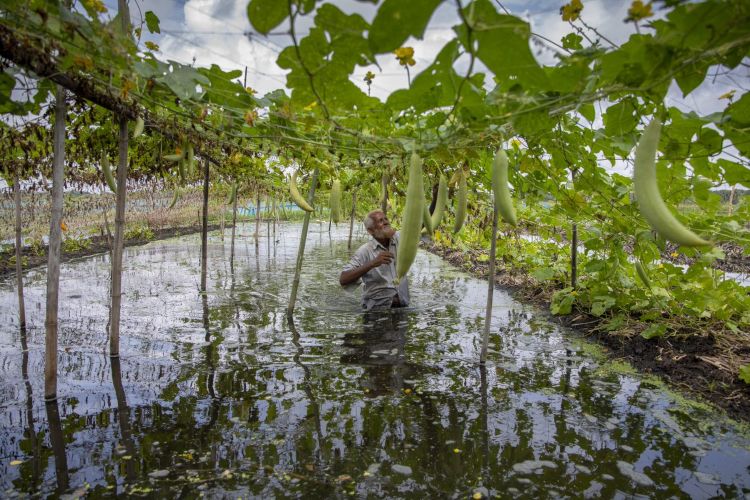Wetlands and climate change: A more potent connection than meets the eye

Dhaka, 8 September, 2020: The overlooked potential of wetlands can be a key to building climate change resilience
Natural features in wetlands are proving to be essential in building climate change resilience. Wetlands are either temporarily (eg, intertidal zones) or permanently, (eg, swamps water-infused lands).
Additionally, wetlands are considered the largest ‘carbon sink’ in the world. Despite constituting only 6% of the world landmass, it promotes organic carbon accumulation by carbon sequestration (also ‘blue carbon’) and sediment-trapping which amounts to more carbon storage than all of the world’s forests combined (Mitsch and Gosselink 2015).
Sometimes referred to as ‘space-effective stock’ for carbon, wetlands act as an efficient ‘greenhouse gas sink’, trapping different greenhouse gases, including methane which contributes to global warming more than any other gas. Research says that saline or oxygenated environments, both very common features in wetlands, help to lower the methane emission rate. A report published in 2015 by UNDRR (UN Office for Disaster Risk Reduction) estimated that 90% of climate-related disasters are seemingly water-related and thus, related to wetlands.
The ecological value of wetland proceeds further from just absorbing greenhouse gases, the absorbed ‘carbon’ is used up by the inhabiting organisms to survive and contribute as a vital component of the biosphere.
The wetlands help maintain the hydrological cycle, via its water retention and infiltration in the soil while in the process, helps to filter precipitated water into the groundwater aquifers. As moisture helps regulate temperature, which also aids in controlling atmospheric temperature. The natural cycle of the wetlands helps balance their local microclimates. Additionally, wetlands act as natural buffers for natural disasters.
In Bangladesh, almost 11% of the total area is covered by Wetlands, the Sundarbans being one of them. It is in the south-west region of the country, covered with thick mangrove forest. This year, when cyclone Amphan was about to hit Bangladesh, the presence of the Sundarbans flora abated the impacts by reducing wind speed and breaking the waves.
Similar incidents were reported during cyclone Bulbul and Fani last year. Many such examples of wetlands resisting storms have been reported in Egypt, the USA, and Australia among other instances.
In this regard, it has become crucial to restore and improve the wetland functions with all its resources preserved. Wetland degradation can create some severe, irreversible problems. Loss or contamination of wetland water can lead to desiccated groundwater reservoirs, drought, salinity, peatland wildfires, like the fires in Australia. Not to mention how wildfires release all the stored carbon into the atmosphere, which in the race of lowering carbon footprint, would be a definite debacle for any nation. In the case of tropical countries, cyclones are becoming more and more augmented and floods are becoming recurrent. Specifically, in the coastal areas, this is a hazard.
“In Gazipur, Bangladesh, untreated waste is disposed of near wetlands which contributes to freshwater contamination and pollution”
Wetlands are a common-pool resource, meaning, it can function at its full potential only if the collective interest is sought for. On the other hand, it might lose its resourcefulness if exploited. Big corporations and other organizations with their imprudent policies and projects are depleting the wetland natural resources, ie, biodiversity, renewable fuel, etc.
Plastic pollution in oceans hampers neighbouring wetland ecosystems, eg, in the Great Barrier Reef, whereas, there is no such descent noticed in the use of plastics. Similarly, burning fossil fuels in industries is not only releasing excess CO2 into the atmosphere but also exhausting the non-renewable reserves. In Gazipur, Bangladesh, untreated waste is disposed of near wetlands which contributes to freshwater contamination and pollution.
Wetlands are critical to climate change actions and also to the proposed SDGs (Sustainable Development Goals). If we talk about ‘Climate Action’ (SDG 13), ‘Life Below Water’ (SDG 14) or ‘Life on Land’ (SDG 15), all of these goals directly or indirectly suggest restoration and proper management of wetlands coupled with climate change.
Wetlands have the potential to provide 40% of global renewable ecosystem services. Preserving and restoring these resources through proper investment on wetlands and effective utilization will ensure that the natural potential of the wetlands is retained.
The government should disseminate more river-dredging projects to help save the dying rivers and enhance river and water networks by stimulating siltation processes for better wetland cultivation. Floating beds in the Barisal regions is a classic example of sustainable utilization of wetland resources through adaptability. This way the wetlands would be restored being utilized in an efficient way for safeguarding us from climate change impacts.
Nobel Prize-winning economist Elinor Ostrom stated that common resources are well managed when those who benefit from them the most are in close proximity and that resources are only in danger when left in the hands of external benefactors.
It is self-evident that all the plans proposed for wetland management should be corroborated as ecologically sound. For instance, traditionally managed mangrove forests in Asia are currently being converted for commercial agriculture or urban development. This is a very distorted approach.
Conversely, mangroves, when managed equitably, can prolifically store carbon up to the level of natural sites within just a decade, despite lower tree biomass in the restored sites. A good approach would be “integrating human society with its natural environment for the benefit of both” (Ramsar Convention on Wetlands).
Integrated community-based initiatives are best-fit for such cases, as the locals with required guidance would be able to plan the strategies suitable to them and their environment. This would necessarily help preserve and restore the wetlands. These small yet effective initiatives will confirm the sustainability of the wetlands.
Read More
.

